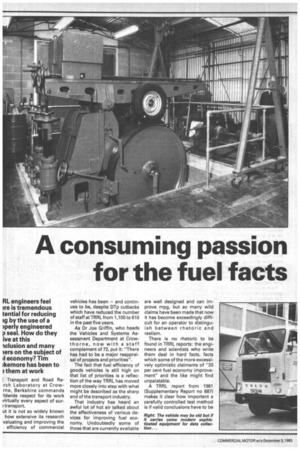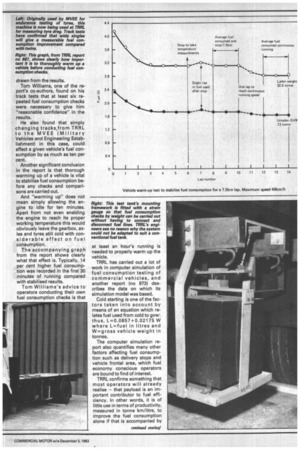A consuming passion for the fuel facts
Page 24

Page 25

Page 26

If you've noticed an error in this article please click here to report it so we can fix it.
RI engineers feel re is tremendous tential for reducing tg by the use of a )perly engineered p seal. How do they ive at this 'elusion and many lers on the subject of :I economy? Tim ikemore has been to them at work Transport and Road Rerch Laboratory at Crowme, Berkshire commands -Idwide respect for its work virtually every aspect of sum: transport.
ut it is not so widely known how extensive its research valuating and improving the efficiency of commercial vehicles has been — and continues to be, despite DTp cutbacks which have reduced the number of staff at TRRL from 1,100 to 610 in the past five years.
As Dr Joe Griffin, who heads the Vehicles and Systems Assessment Department at Crowthorne, now with a staff complement of 72, put it: "There has had to be a major reappraisal of projects and priorities".
The fact that fuel efficiency of goods vehicles is still high on that list of priorities is a reflection of the way TRRL has moved more closely into step with what might be described as the sharp end of the transport industry.
That industry has heard an awful lot of hot air talked about the effectiveness of various devices for improving fuel economy. Undoubtedly some of those that are currently available are well designed and can improve mpg, but so many wild claims have been made that now it has become exceedingly difficult for an operator to distinguish between rhetoric and realism.
There is no rhetoric to be found in TRRL reports: the engineers and scientists who write them deal in hard facts, facts which some of the more excessively optimistic claimants of "20 per cent fuel economy improvement" and the like might find unpalatable.
A TRRL report from 1981 (Supplementary Report no 687) makes it clear how important a carefully controlled test method is if valid conclusions have to be drawn from the results.
Tom Williams, one of the report's co-authors, found on his track tests that at least six repeated fuel consumption checks were necessary to give him "reasonable confidence" in the results.
He also found that simply changing tracks,from TRRL to the MVEE (Military Vehicles and Engineering Establishment) in this case, could affect a given vehicle's fuel consumption by as much as ten per cent.
Another significant conclusion in the report is that thorough warming up of a vehicle is vital to stabilise fuel consumption before any checks and compari sons are carried out.
And "warming up" does not mean simply allowing the engine to idle for ten minutes. Apart from not even enabling the engine to reach its proper working temperature this would obviously leave the gearbox, axles and tyres still cold with considerable effect on fuel consumption.
The accompanying graph from the report shows clearly what that effect is. Typically, 14 per cent higher fuel consumption was recorded in the first 30 minutes of running compared with stabilised results.
Tom Williams's advice to operators conducting their own fuel consumption checks is that at least an hour's running is needed to properly warm up the vehicle.
TRRL has carried out a lot of work in computer simulation of fuel consumption testing of commercial vehicles, and another report (no 973) des cribes the data on which its simulation model was based.
Cold starting is one of the factors taken into account by means of an equation which relates fuel used from cold to gvw: thus, L--0.0857+0.02175 W where L=fuel in litres and W:=---gross vehicle weight in tonnes.
The computer simulation report also quantifies many other factors affecting fuel consumption such as delivery stops and vehicle frontal area, which fuel economy conscious operators are bound to find of interest.
TRRL confirms something that most operators will already realise — that payload is an important contributor to fuel efficiency. In other words, it is of little use in terms of productivity, measured in tonne km/litre, to improve the fuel consumption alone if that is accompanied by lificantly reduced payload. put another way, the best to improve your vehicle's rail fuel economy might be ply to increase its payload Or.
'hermostatically controlled is and radiator shutters, haps surprisingly, do not fee) strongly in TRRL reports on I economy. One conclusion is I they have been shown to ir savings of "up to about 5 cent", but this depends to a le extent upon the vehicles to ch the devices are fitted and amount of laden and unlarunning".
here is no doubt though iut the value of radial tyres I wide singles. Track tests e shown "savings of around er cent in fuel consumption radial tyres compared with 9sply and a further 3 per cent an using wide singles instead lual radial tyres".
he effect of misalignment of as on a semi-trailer tandem lie has been quantified too. One degree out of true will put up fuel consumption by about 3 per cent, just because of the tyre scrub.
Scrub on tri-axle bogies, even properly aligned ones, is particularly topical but TRRL has not yet compared a conventional bogie with one with a self-steered trailing axle. However, that is on the list of possible future projects, as are tests on low profile tyres.
Devices for reducing drag coefficients of commercial vehicles have tended to be the one for which some of the wildest claims for fuel economy improvements have been made.
TRRL's work on aerodynamic efficiency has already revealed some interesting results. For example, a BOC Transhield articulated combination comprising a Bedford TM tractive unit and van semi-trailer fitted with the familiar BOC boxed-in front mounted refrigeration unit was tested with and without a slightly convex roof mounted air deflector.
It gave no improvement in fuel consumption on both track and road and subsequent wind tunnel tests at Cranfield Institute of Technology confirmed that it was not having any favourable effect on the vehicle's Cd (drag coefficient).
Further tests with both a rigid and articulated vehicle revealed that an under bumper air dam was having "no measurable effect compared with the standard vehicle".
It should not be deduced from this that TRRL is strongly op posed to drag-reducing devices. On the contrary certain types are strongly recommended, but one of the key points that is emphasised is that "aerodynamic effects are interdependent and the effect of combinations of devices is not readily predictable".
Until quite recently the fact that in practice commercial vehicles spend most of their time operating in crosswinds was conveniently ignored by many manufacturers of drag-reducing devices but now vehicle manufacturers, notably Leyland, Scania and Mercedes, have put their own and TRRL's wind-tunnel work into developing aids which reduce the wind averaged drag coefficient.
This coefficient was defined by TRRL staff to give them a more meaningful measure of a vehicle's aerodynamic effi ciency. It is measured in a wind tunnel by yawing the vehicle re lative to the wind direction, and takes into account the distribution of wind speeds in Great Britain.
The difference between simple drag coefficient (Cd) and wind averaged drag coefficient (Cd) is significant, (Cd is always greater), though it depends to a large extent on body type. TRRL has found, for example, that compact vehicles such as light vans or short wheelbase tankers have wind averaged drag less than 10 per cent greater than the drag at zero yaw while a long wheelbase box bodied rigid or drawbar combination will prob ably have a 30 per cent higher wind averaged drag coefficient. At present, TRRL, together with the College of Aeronautics at Cranfield, is looking closely at the differences between wind tunnel measurements, usually 1/8 or 1/10 scale models and those found in practice at full scale. it seems likely that windtunnel drag results will need to be increased by something more than 13 per cent to approximate to full scale.
The report dealing with this subject will also include the results of some interesting research into the effect of bolt-on drag-reducing devices and is likely to be published within the next twelve months. Already though it has become clear that some types of device are very effective.
Alan Naysmith of TRRL, who has done a lot of work on drag, unreservedly recommends the vortex retaining type of moulding for Luton-headed vehicles. He describes Luton-bodied light vehicles in standard trim as having "diabolical" aerodyanarnic characteristics with tremendous potential for improvement.
The vortex retaining moulding (that is the quite large radius, hemispherical section, goal post shaped device, that fits on the front face of the Luton head) can reduce the drag coefficient by 30 per cent, leading to an average fuel consumption improvement of around 10 per cent.
This will depend to some extent on the vehicle's duty cycle but even for a vehicle dedicated to urban delivery work, significant savings can be made.
TRRL's engineers also have favourable comments for the principle of tractive unit/semitrailer gap sealing, but they recognise the practical difficulties caused by the devices currently available. When used with a correctly designed roof mounted air deflector a properly engineered gap seal "offers tremendous potential" for reducing drag, according to TRRL's engineers but they are unimpressed with the models they have seen so far.
"We don't think there is an adequately engineered one on the market" is their opinion.




























































































